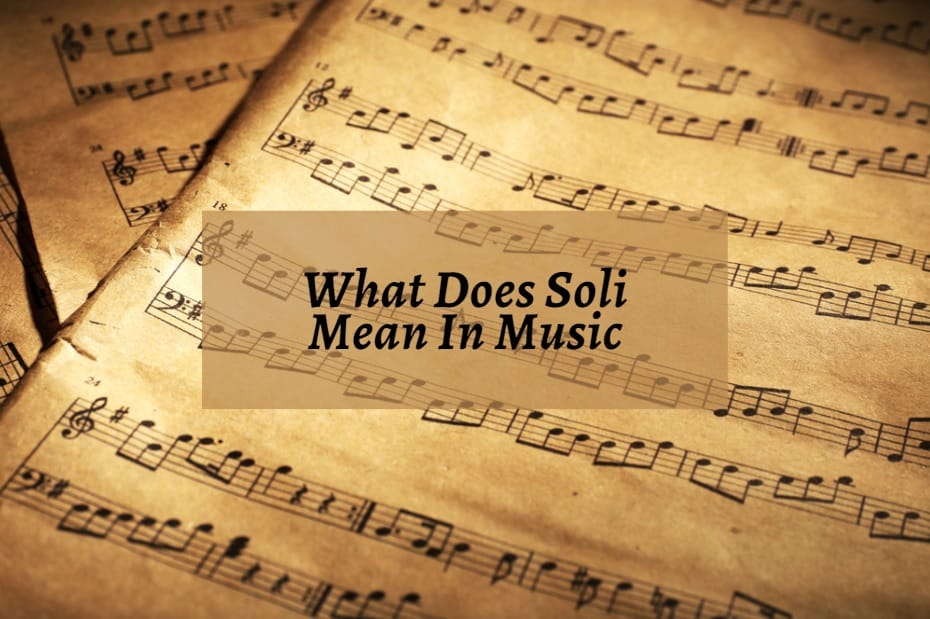
What Does Soli Mean In Music
There is a vast quantity of musical terms that often-become compulsory learning for many aspiring musicians. These range from instructions to play quieter or louder through to playing quicker or slower.
Nearly all of these musical words stem from the Italian language although these days most composers will write directions in their native language.
Some instructions written into scores are more commonly found in certain types of music. The word soli is a word I first came across when playing in an orchestra and it was not one I had seen written down before.
In truth, at the time, I largely ignored it until I had my next lesson when I decided to consult my teacher. What my teacher did not tell me was that ‘Soli’ is a studio album by Adriano Celentano or an ancient town in Asia Minor. What he did say was that soli is the plural of solo.
For a short time, until I played that orchestral passage again and listened properly to what was going on around me, his comment made little sense. I did know what solo meant as I had been familiar with this term for a long time.
It was written on the covers of books I had studied and in concertos, I had learned. So, if solo meant alone, then what did my teacher mean by the plural of solo?
Soli usually refers to a passage of music that is played by a soloist whose melodic line is then doubled by another player. They might be in the same section, for example, woodwind, or in another section.
Combining the performance of the melody across instrumental groupings brings distinct colouration to an orchestral piece. It is also worth noting as a minor diversion, that following the instruction soli, you may well encounter the term tutti.
This reminds the performers that they are no longer in the shared solo position, but back with everyone.
Sometimes soli can also mean a passage played with the soloist playing along with the orchestra. This is something you often read in baroque scores like Vivaldi’s Quatro Staggioni of The Four Seasons.
Indeed, you even find in later concertos that the solo part offers the soloist the opportunity to play with the orchestra at the start of the piece.
The difference is marked in the concerto grosso of the earlier periods where the soloist may have led the ensemble and played with them before the solo passages would have been usual.
Back in the more modern orchestral setting, I have also come across the word soli used in a slightly different manner. What I am referring to is the direction from the composer, or arranger, for the principal member of that group to play that passage.
In this case, this direction was also shown in the principle parts of members of other sections. The intention is to dramatically reduce the players performing a specific musical passage to only include the principal players.
If this was applied to the woodwind section, for example, then instead of hearing three flutes, clarinets, oboes, and bassoons, you would only hear one of each playing that melody. It brings an immediate intimacy to that part of the score.
You could be lured into the false assumption that soli only applies in the classical world of music. This is not the case. If you have an interest in Jazz, and notably Big Band Jazz, then you will be aware of the different sections that go to make up that band.
These include the saxophones, trumpets and trombones, and piano, bass, and drums (rhythm section). Often the melodic and harmonic interest passes between or is shared by the melody instruments.
Arrangers commonly voice these sections in order of range. The sax section for example would give the higher notes to the altos with the baritone bringing up the darker pitches.
This is important to understand as soli in Jazz relates directly to these instrumental sections I mentioned above. To a Jazz arranger, getting the right sound for a soli is like having your individual musical signature that is both unmistakably yours and essential to the arrangement.
Soli in Jazz is a passage of music that involves a group or section playing a fully harmonised melody. Making this work in a Jazz Big Band is not easy and takes great skill. In a way, this soli is similar to the Baroque version even if the harmonic content is a universe away.
The idea of soli passages travels into choral music too. Whilst it is perhaps less common in earlier music, conventions in contemporary music are radically different.
Choirs are frequently divided up into soprano, alto, tenor, and bass voices, from highest to lowest registers. Often greater in numbers, the sopranos and altos can be further divided into second soprano and alto groups.
What this does is allow the composer the opportunity to explore the sonorities within these sub-groups. Here is where you might find the idea of soli in action where a single female voice is accompanied by her fellow section members.
Textural variations and intricacies become avenues of fascination brought about by the use of soli.
Italian musical terminology continues to remain staunchly in place. The conventions that were set in place centuries ago seem to still have a hold over the musical domain. It makes sense in many ways, after all, why change something that works well.
The only caveat is the interpretive aspect of the language. As you can see from the short survey above, just one word can enjoy many different settings across many different genres of music.
The next time you glance through a score, look out for passages marked soli and maybe you will hear them with fresh ears.
